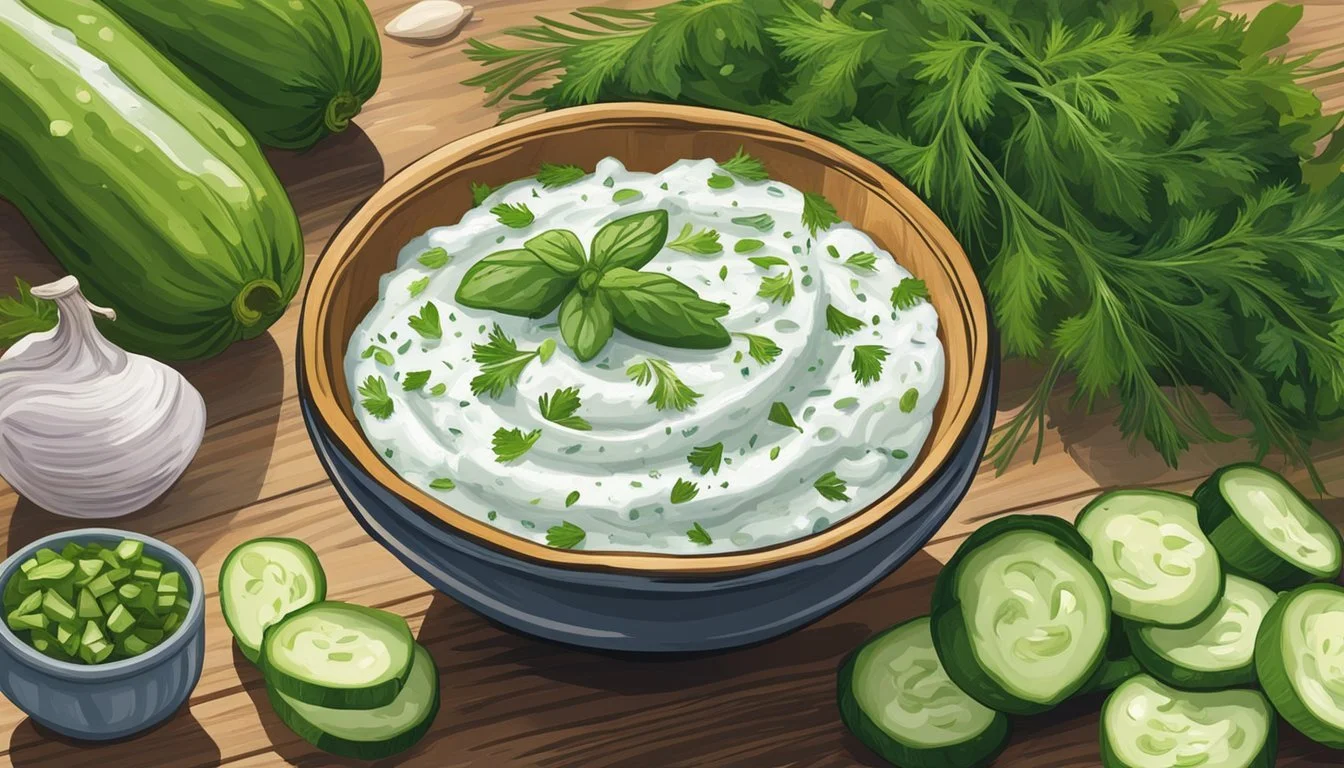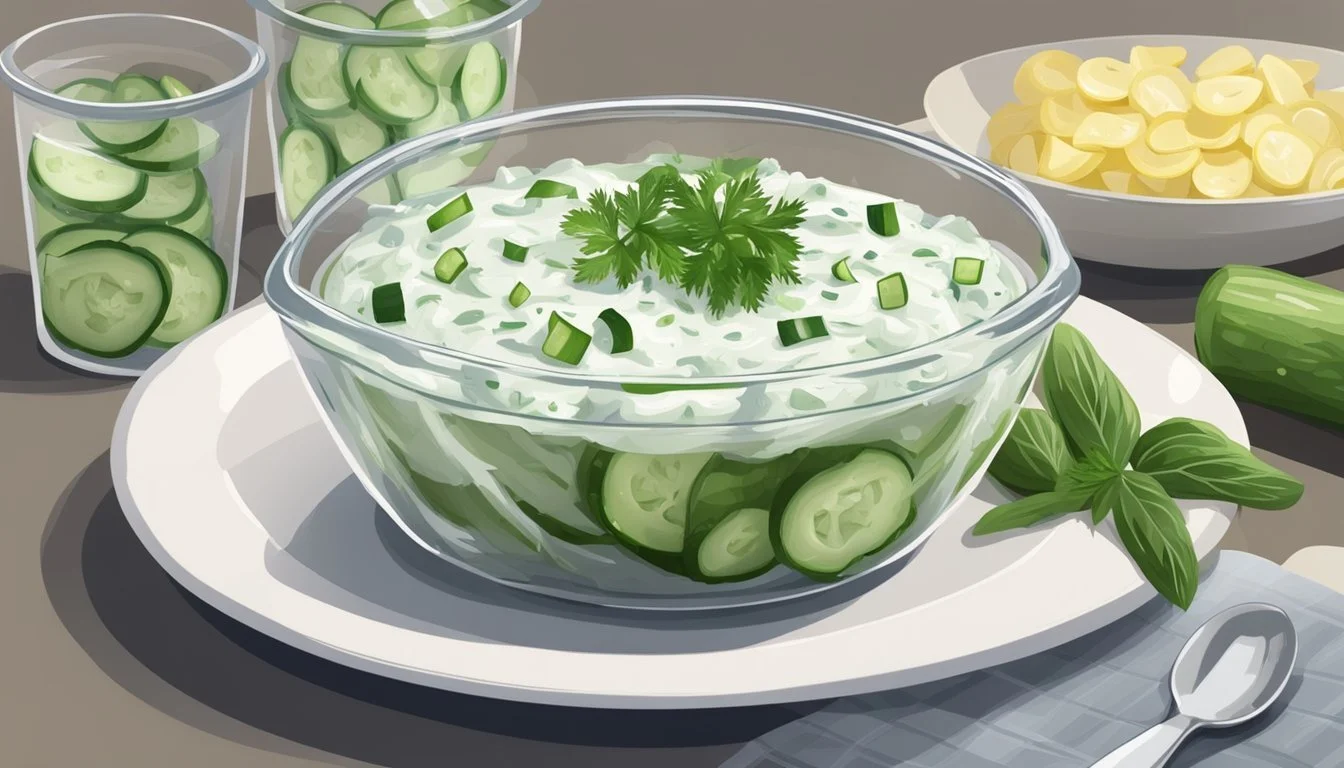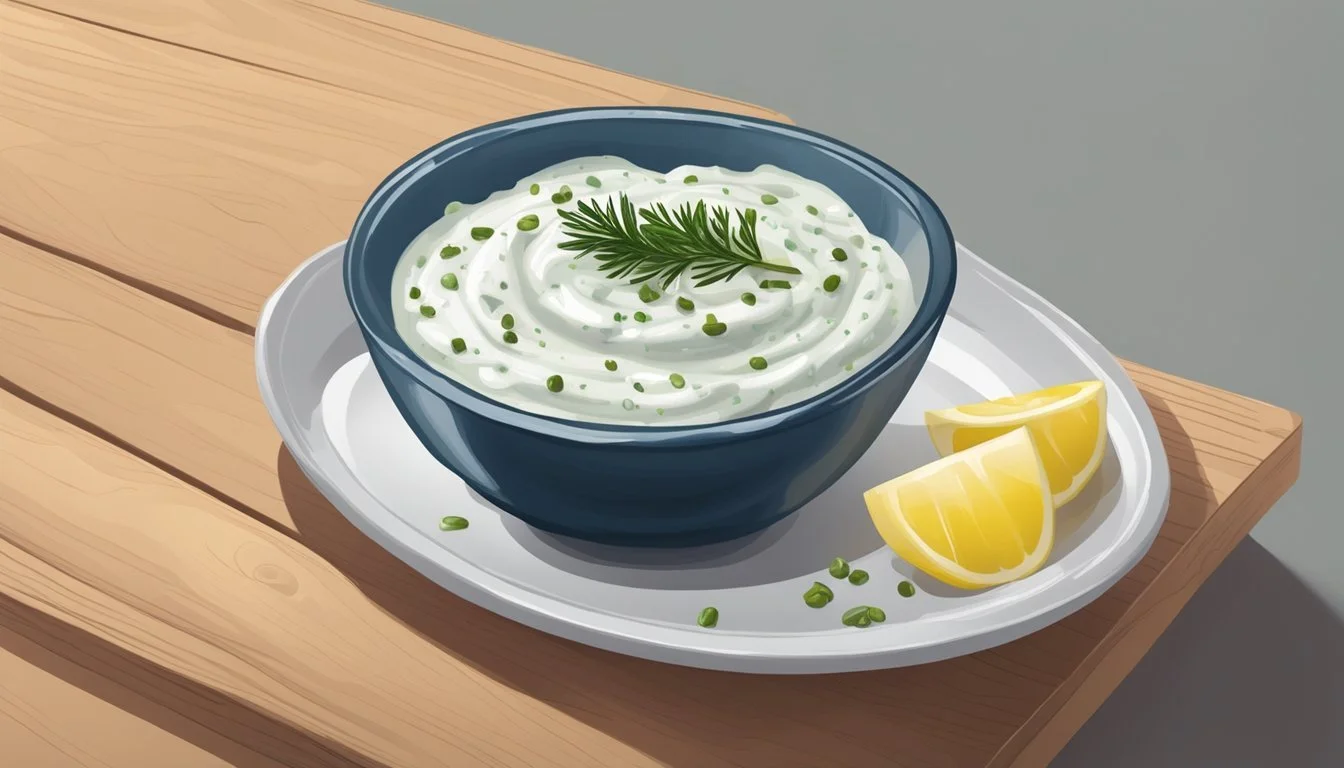How Long Does Tzatziki Last?
Shelf Life and Storage Tips
Tzatziki, a creamy and refreshing dip, is a staple in Greek cuisine and enjoyed worldwide for its unique blend of ingredients. Traditionally made from yogurt, cucumbers (how long do cucumbers last?), garlic, and herbs, tzatziki can elevate the flavors of a variety of dishes, from grilled meats (What wine goes well with grilled meats?) to simple vegetable platters. The dip’s longevity after preparation is often questioned, as it contains dairy and fresh produce, both of which are known to have limited shelf lives.
The shelf life of tzatziki is contingent upon the ingredients used and how it is stored. Homemade tzatziki's freshness is linked closely to the yogurt's quality, as well as to the absence of preservatives, which generally allows the dip to last for about 3-4 days when refrigerated in an airtight container. In contrast, store-bought tzatziki often includes preservatives, enabling it to potentially remain edible for up to two weeks when similarly stored under refrigeration.
It's important to ensure tzatziki is kept cold, as the yogurt and cucumber components are sensitive to temperature, and any deviations from proper storage can adversely affect both its flavor and safety for consumption. Consistent refrigeration and airtight storage are thus critical to preserving tzatziki’s taste and preventing spoilage. The presence of live, active cultures in yogurt may help somewhat to preserve the dip, but this should not be solely relied upon for extending its shelf life beyond the standard recommendations.
Understanding Tzatziki
Tzatziki is a savory yogurt-based condiment that has been integral to Mediterranean cuisine. This section explores its rich flavors, origins, and how different varieties cater to a range of dietary preferences.
Ingredients and Flavor Profiles
Tzatziki's signature flavor comes from a blend of plain Greek yogurt, grated cucumber, garlic, lemon juice, and olive oil. Herbs such as fresh dill (how long does dill last?) or mint provide an aromatic touch, while a pinch of salt enhances the overall taste. The result is a refreshingly tangy and creamy sauce with a hint of garlic.
Origin and Culinary Uses
Originating from the Middle East and popularized by Mediterranean culinary traditions, tzatziki is often used as a condiment, spread, or topping in dishes such as gyros, souvlaki, falafel, and kebabs.
Nutritional Value
With plain Greek yogurt as its base, tzatziki is rich in protein and can be a healthy option that may contain probiotics. Full-fat Greek yogurt gives a richer texture, while low-fat versions provide a lighter alternative.
Homemade vs Store-Bought Varieties
Homemade tzatziki sauce tends to be fresher and free of preservatives, preserving the quality and flavor profiles of its fresh ingredients. In contrast, store-bought tzatziki sauce might include preservatives to extend its shelf life.
Vegan and Vegetarian Variations
Plant-based alternatives to traditional tzatziki use dairy-free yogurt made from sources like soy or coconut. These vegan and vegetarian options incorporate similar herbs and flavor profiles as the classic recipe.
Food Pairings
Tzatziki pairs harmoniously with a variety of foods. It's delightful with pita bread, grilled meats, vegetables, salads, and can complement other dips like hummus.
Making Tzatziki from Scratch
To create homemade tzatziki, you'll need strained yogurt and grated cucumber—preferably using a box grater for the right consistency. Freshly prepared tzatziki is a testament to the simple yet robust flavors of Mediterranean cuisine.
Customizing the Recipe
Customization of the tzatziki recipe allows it to cater to personal taste preferences and dietary needs. Ingredients such as vinegar or different herbs can be adjusted, and the consistency modified with additions like water or extra yogurt.
Proper Storage Techniques
Proper storage of tzatziki is essential to maintain its texture and flavor while ensuring it stays safe to consume. This section outlines specific storage recommendations to help extend the lifespan of this beloved condiment.
Refrigerating Tzatziki
Freshly made tzatziki or an opened container of store-bought tzatziki should be kept refrigerated at a consistent temperature, ideally at 40°F (4°C) or below. They should place it in an airtight container to prevent it from absorbing odors from other foods in the refrigerator. The shelf life of tzatziki in the fridge generally lasts up to four to seven days, given that the yogurt used is fresh.
Extending Shelf Life
To further extend the shelf life of tzatziki, individuals should ensure all utensils used are clean to reduce bacterial contamination. Adding a thin layer of olive oil on top of the tzatziki before sealing the container can help create a barrier against bacteria. Moreover, ingredients like lemon juice, vinegar, and salt not only enhance flavor but also act as natural preservatives that may help in prolonging freshness.
Freezing Recommendations
Although freezing tzatziki is not commonly recommended due to potential changes in texture upon thawing, some may still wish to freeze leftovers. If one decides to freeze tzatziki, they should do so in small portions within an airtight container or a heavy-duty freezer bag. It is important to note that once frozen and then thawed, tzatziki is best used in cooked dishes where changes in texture are less noticeable. The sauce can be kept frozen for one to two months for optimal quality.
Recognizing Spoilage
When it comes to tzatziki, a popular Mediterranean sauce made primarily from yogurt, cucumber, and olive oil, being able to identify when it has gone bad is crucial for health and enjoyment. Spoiled tzatziki can lead to foodborne illnesses, so understanding the signs of spoilage is important for safe consumption.
Visual and Scent Cues
A fresh batch of tzatziki should have a creamy texture and a white to light-green color, depending on the amount of cucumber and herbs used. With time, the sauce may separate, with liquid pooling at the top, which can be a normal occurrence and remedied by stirring. However, key indications of spoilage include:
Discoloration: Any off-white, yellowish, or green tint not attributed to herbs may indicate spoilage.
Texture Changes: Creaminess turning into watery consistency or lumpiness.
Mold Growth: Any visible mold or fuzzy spots require immediate disposal of the sauce.
Sour Smell: Instead of a fresh and tangy aroma, a sour or off-putting odor signifies spoilage.
One should also check for the expiration date on store-bought tzatziki and consider discarding it past this time frame, even if the telltale signs of spoilage are absent.
Safety and Consumption Guidelines
To minimize the risk of contamination, tzatziki should always be stored in the refrigerator in a tightly sealed container, preferably away from raw foods to prevent cross-contamination. If stored properly, homemade tzatziki can last for about 3-4 days, while store-bought versions may last longer due to preservatives. The following guidelines should be heeded:
Expiration Dates: Store-bought tzatziki typically provides an expiration date. Abide by it to ensure quality.
Leftover Tzatziki: Use clean utensils each time to prevent introducing bacteria into the sauce.
Discard Promptly: If any signs of spoilage are present, it's best to err on the side of caution and discard the questionable tzatziki to avoid ingestion of harmful bacteria.
By paying close attention to these factors, one can ensure that their enjoyment of tzatziki does not come at the cost of their health.
Serving Suggestions
Tzatziki, a versatile Greek sauce with a refreshing flavor, enhances a variety of dishes beyond its traditional use. This section provides guidance on ideal serving conditions, innovative culinary applications, and recommended pairings.
Optimal Serving Conditions
For best flavor and safety, tzatziki should be served chilled; it should be stored in an airtight container and can remain at room temperature only briefly during serving. Always use clean utensils to prevent contamination and preserve quality.
Creative Uses in Dishes
Tzatziki's creamy texture and tangy taste make it an ideal spread on sandwiches or gyro sauce. As a garnish, it adds a cooling element when dolloped atop spicy dishes like kebabs or falafel. It can also be incorporated into salads or served alongside hummus for a medley of Mediterranean flavors.
Accompaniments and Sides
Traditional sides for tzatziki often include pita bread, grilled meats, and a variety of vegetables. It adds zest when used as a dip for crudités or as a flavorful garnish to enhance salads. Its role as a condiment for gyros or as a refreshing counterpart to warm dishes such as pita sandwiches makes it a multifaceted component in Greek cuisine.
Frequently Asked Questions
When considering tzatziki, a delightful yogurt-based sauce enriched with cucumber, garlic, and sometimes olive oil, consumers often inquire about its longevity, ways to refresh leftovers, and health implications.
Shelf Life Expectancy
Homemade Tzatziki: Typically, homemade tzatziki lasts for 3-4 days when stored in the refrigerator in an airtight container. Store-Bought Tzatziki: Due to preservatives, it can last 5-7 days under similar refrigeration conditions. The high acidity of tzatziki sauce, primarily from added lemon juice, usually prolongs its shelf life.
Reviving Leftover Tzatziki
The texture of tzatziki may separate over time, with liquid settling at the top. To revive leftovers, simply stir it to reincorporate the ingredients. Adding a small amount of fresh cucumber or a drizzle of olive oil can enhance the taste and consistency of tzatziki that has been refrigerated for a few days.
Health Considerations
Nutrition: Tzatziki made with full-fat Greek yogurt offers beneficial probiotics that support gut health. Spoilage: Taste and smell are reliable indicators of spoilage; any sour or off odors are a clear sign the sauce should be discarded. Always inspect tzatziki for signs of mold or an unusual change in texture before consumption to ensure it's healthy to eat.
Conclusion
Shelf Life of Tzatziki The longevity of tzatziki largely hinges on its storage conditions. Homemade tzatziki should ideally be consumed within 3-5 days when kept in the refrigerator in an airtight container. Store-bought varieties may last longer, up to two weeks, due to added preservatives.
Storage Recommendations To extend its freshness, tzatziki should be refrigerated promptly. It's essential to store it in a container that seals tightly to maintain its flavor and prevent contamination.
Considerations for Ingredients The lifespan of tzatziki can also be influenced by the freshness of its ingredients upon preparation. Fresh yogurt and cucumber are crucial to not only the flavor but also for how well the tzatziki holds up over time.
Flavor and Quality While the tzatziki might be safe to eat after the 3-5 day window, one should observe it for any changes in taste or texture. It's important, regardless of its shelf life, to enjoy tzatziki while it retains its peak quality.
Using Tzatziki Tzatziki serves as a versatile addition to meals, commonly used as a dip or garnish. Its rich flavor complements a variety of dishes, enhancing the taste profiles of grilled meats, salads, or simply as a stand-alone snack.
Final Inspection Before consuming, one should always examine the tzatziki for any signs of spoilage such as odor, taste, or mold, to ensure food safety.
Sources and References
In the research of tzatziki's shelf life, several culinary and food safety sources were consulted. These sources provide guidelines based on the components of tzatziki such as yogurt, cucumber, and garlic, as well as storage conditions.
EatDelights mentions yogurt quantity influencing lifespan, suggesting four days of freshness in the fridge.
Chef's Resource offers a window of 5 to 7 days in refrigeration, highlighting airtight containers for proper storage to guard against cross-contamination.
From Eat Pallet, there's an emphasis on the freshness of the yogurt as a critical factor, with a suggested shelf life of four days in the refrigerator for homemade tzatziki.
Chef Olu contrasts homemade tzatziki—which they cite as lasting about four days—with store-bought versions that could last up to two weeks under refrigerated conditions.
Finally, Spoonful of Si proffers preparation guidance but does not directly address shelf life.
Source Provided Shelf Life Additional Information EatDelights Approx. 4 days Influence of yogurt quantity Chef's Resource 5 to 7 days Importance of airtight containers Eat Pallet Approx. 4 days Freshness of yogurt as a contributing factor Chef Olu 4 days to 2 weeks Difference between homemade and store-bought Spoonful of Si N/A Recipe instructions; does not specify shelf life
These references are utilized for their relevant insights on maintaining tzatziki's freshness and preventing spoilage while in storage.
Glossary of Terms
Tzatziki
A traditional Greek sauce made from yogurt, cucumber, garlic, olive oil, and herbs like dill or mint.
Shelf Life
The length of time a food product remains safe to consume and retains its desired quality under specific storage conditions.
Homemade Tzatziki
Tzatziki prepared at home typically without preservatives, affecting its shelf life.
Store-Bought Tzatziki
Commercially produced Tzatziki which often includes preservatives to extend its shelf life beyond that of homemade varieties.
Airtight Container
A container that prevents air from entering or exiting, crucial to preserving tzatziki's freshness in the refrigerator.
Preservatives
Substances added to food products to prevent spoilage and extend shelf life.
Refrigerator Storage
The recommended method of keeping tzatziki fresh, which involves storing it at a low temperature to slow bacterial growth.
Signs of Spoilage
Visual, textural, or olfactory indicators that a food product, such as tzatziki, has gone bad.
Dietary Restrictions
Limitations on food consumption that can include avoiding certain ingredients due to health, ethical, or religious reasons.
Vegan/Dairy-Free Varieties
Forms of tzatziki that have been adjusted to remove dairy ingredients, catering to specific dietary needs.
Live and Active Cultures
Beneficial bacteria found in some dairy products, contributing to the preservation of homemade tzatziki.









